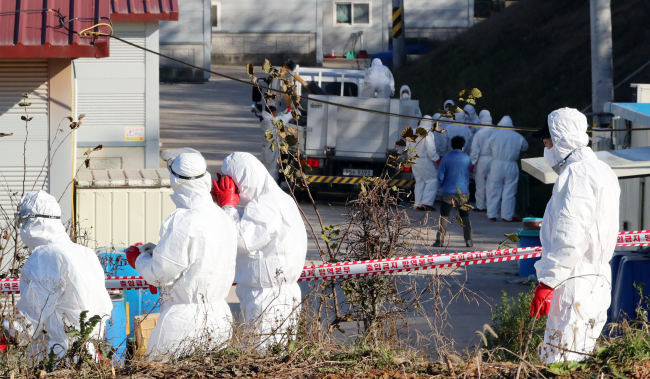South Korean authorities are in hot water after failing to properly deal with the outbreak of a highly pathogenic bird flu in the country, which swept through neighboring countries earlier this year, killing over 20 people.
According to Rep. Kim Hyun-kwon of the opposition Democratic Party of Korea, the quarantine authorities first detected the bird flu from feces of migratory birds on Oct. 28.
On Nov. 10, the virus was confirmed to be H5N1, a highly contagious strain of avian influenza that also has a high mortality rate.
But the government did not activate a quarantine program and emergency operation system until Nov. 16, when the virus struck two farms -- a chicken farm in Haenam, South Jeolla Province, and a duck farm in Eumseong, North Chungcheong Province, Rep. Kwon said.
According to Rep. Kim Hyun-kwon of the opposition Democratic Party of Korea, the quarantine authorities first detected the bird flu from feces of migratory birds on Oct. 28.
On Nov. 10, the virus was confirmed to be H5N1, a highly contagious strain of avian influenza that also has a high mortality rate.
But the government did not activate a quarantine program and emergency operation system until Nov. 16, when the virus struck two farms -- a chicken farm in Haenam, South Jeolla Province, and a duck farm in Eumseong, North Chungcheong Province, Rep. Kwon said.

“The government should have immediately activated quarantine measures when the AI virus was first detected. Then the virus would have not penetrated into poultry farms along the west coast and spread to Gyeonggi Province, Chungcheong and Jeolla regions within just two weeks,” said Rep. Kim.
So far, 41 bird flu cases have been confirmed in the country since the first outbreak. Some 1 million animals have been culled.
As reports of suspected AI outbreaks continue, the Ministry of Agriculture, Food and Rural Affairs last week has raised the watch level to “alert” from “caution,” ordering every provincial government to run emergency operation centers and strengthen disinfection measures in all farming areas.
It also banned stockbreeders at some 89,000 poultry farms from moving for 48 hours on Saturday to contain and eliminate the virus.
Experts say that South Korea should have been more vigilant over the possibility of a bird flu outbreak, stepping up both monitoring and inspections for the seasonal ailment.
Currently, bird flu inspections occur three to four times a year between December and April. Inspections are mostly led by local authorities.
“When poultry farms report deaths of chickens or ducks to the authorities, it is already after the virus has spread, so authorities cannot rule out the possibility that the virus had spread to adjacent farms,” said professor Seo Sang-hee from Chungnam National University’s College of Veterinary Medicine.
“The government should run inspections regularly at poultry farms as well, not just by collecting and analyzing feces of migratory birds,” Seo added.
Meanwhile, a duck farm in Naju, South Jeolla Province, the country’s largest duck production base, reported a possible outbreak with drastically fallen spawning rate.
On Monday, the Animal and Plant Quarantine Agency announced the result of a bird flu virogene analysis and said the detected H5N6 is similar to cases found in China, Vietnam, Laos and Hong Kong.
In China, there have been 16 H5N6 cases of human infections since 2014. Ten of those infected have died.
By Kim Da-sol (ddd@heraldcorp.com)
So far, 41 bird flu cases have been confirmed in the country since the first outbreak. Some 1 million animals have been culled.
As reports of suspected AI outbreaks continue, the Ministry of Agriculture, Food and Rural Affairs last week has raised the watch level to “alert” from “caution,” ordering every provincial government to run emergency operation centers and strengthen disinfection measures in all farming areas.
It also banned stockbreeders at some 89,000 poultry farms from moving for 48 hours on Saturday to contain and eliminate the virus.
Experts say that South Korea should have been more vigilant over the possibility of a bird flu outbreak, stepping up both monitoring and inspections for the seasonal ailment.
Currently, bird flu inspections occur three to four times a year between December and April. Inspections are mostly led by local authorities.
“When poultry farms report deaths of chickens or ducks to the authorities, it is already after the virus has spread, so authorities cannot rule out the possibility that the virus had spread to adjacent farms,” said professor Seo Sang-hee from Chungnam National University’s College of Veterinary Medicine.
“The government should run inspections regularly at poultry farms as well, not just by collecting and analyzing feces of migratory birds,” Seo added.
Meanwhile, a duck farm in Naju, South Jeolla Province, the country’s largest duck production base, reported a possible outbreak with drastically fallen spawning rate.
On Monday, the Animal and Plant Quarantine Agency announced the result of a bird flu virogene analysis and said the detected H5N6 is similar to cases found in China, Vietnam, Laos and Hong Kong.
In China, there have been 16 H5N6 cases of human infections since 2014. Ten of those infected have died.
By Kim Da-sol (ddd@heraldcorp.com)








![[Kim Seong-kon] Democracy and the future of South Korea](http://res.heraldm.com/phpwas/restmb_idxmake.php?idx=644&simg=/content/image/2024/04/16/20240416050802_0.jpg&u=)








![[KH Explains] Hyundai's full hybrid edge to pay off amid slow transition to pure EVs](http://res.heraldm.com/phpwas/restmb_idxmake.php?idx=652&simg=/content/image/2024/04/18/20240418050645_0.jpg&u=20240418181020)

![[Today’s K-pop] Zico drops snippet of collaboration with Jennie](http://res.heraldm.com/phpwas/restmb_idxmake.php?idx=642&simg=/content/image/2024/04/18/20240418050702_0.jpg&u=)